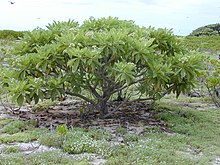Heliotropium arboreum
| Heliotropium arboreum | |
|---|---|

| |
| In the Hawaiian Islands | |
| Scientific classification | |
| Kingdom: | Plantae |
| Clade: | Tracheophytes |
| Clade: | Angiosperms |
| Clade: | Eudicots |
| Clade: | Asterids |
| Order: | Boraginales |
| Family: | Boraginaceae |
| Genus: | Heliotropium |
| Species: | H. arboreum
|
| Binomial name | |
| Heliotropium arboreum (Blanco) Mabb.
| |
| Synonyms | |
| |
Heliotropium arboreum is a species of flowering plant in the borage family, Boraginaceae. It is native to tropical Asia including southern China, Madagascar, northern Australia, and most of the atolls and high islands of Micronesia and Polynesia. Common names include velvetleaf soldierbush,[2] tree heliotrope, veloutier, and octopus bush. It is a shrub or small tree typical of littoral zones reaching a height of 3.6 m (12 ft), with a spread of about 5 m (16 ft).[citation needed]
Taxonomy
Originally published as Tournefortia argentea, it was transferred to Argusia argentea, and remained under that name until recently. It was subsequently restored to the genus Tournefortia before being transferred into the genus Heliotropium under a new name in 2003.[3][4]
Uses


Historically in the Maldives the leaves were often used as famine food.[5]
Wood
The wood of H. arboreum is commonly used to make handicrafts, tools, and, in Polynesia, frames for swim goggles. Due to its availability, H. arboreum is used as firewood, and has become rare in some areas as a result.[6]
Medicinal
Octopus bush is used in many Pacific islands as a traditional medicine to treat ciguatera fish poisoning, which is caused by powerful ciguatoxins produced by microscopic Gambierdiscus algae. Scientists from the Institute of Research for Development (IRD) and the Louis Malarde Institute in French Polynesia and Pasteur Institute in New Caledonia are researching the plant chemistry and believe that senescent leaves contain rosmarinic acid and derivatives, which are known for its antiviral, antibacterial, antioxidant, and anti-inflammatory properties.[7] The researchers think that rosmarinic acid removes the ciguatoxins from their sites of action, as well as being an anti-inflammatory agent.
References
- ^ Razafiniary, V.; Hills, R. (2021). "Heliotropium arboreum". IUCN Red List of Threatened Species. 2021: e.T165436903A165436944. doi:10.2305/IUCN.UK.2021-1.RLTS.T165436903A165436944.en. Retrieved 16 November 2021.
- ^ NRCS. "Tournefortia argentea". PLANTS Database. United States Department of Agriculture (USDA). Retrieved 11 December 2015.
- ^ Hilger, Hartmut H. (1 December 2003). "IngentaConnect A systematic analysis of Heliotropiaceae (Boraginales) based on t". Botanische Jahrbücher. 125: 19–51. doi:10.1127/0006-8152/2003/0125-0019.
- ^ "Heliotropium foertherianum Diane & Hilger". Australian Plant Name Index (APNI), IBIS database. Centre for Plant Biodiversity Research, Australian Government.
- ^ Eating on the Islands - As times have changed, so has the Maldives' unique cuisine and culture
- ^ Elevitch, Craig R.; Harley I. Manner (April 2006). "Tournefortia argentea (tree heliotrope)" (Document). The Traditional Tree Initiative.
{{cite document}}: Unknown parameter|url=ignored (help) - ^ Rossi F, Jullian V, Pawlowiez R, Kumar-Roiné S, Haddad M, Darius HT, Gaertner-Mazouni N, Chinain M, and Laurent D (August 2012). "Protective effect of Heliotropium foertherianum (Boraginaceae) folk remedy and its active compound, rosmarinic acid, against a Pacific ciguatoxin". Journal of Ethnopharmacology. 143 (1) (published 30 August 2012): 33–40. doi:10.1016/j.jep.2012.05.045. PMID 22706150.
External links
 Data related to Heliotropium arboreum at Wikispecies
Data related to Heliotropium arboreum at Wikispecies- Plants of Midway Atoll
- IUCN Red List least concern species
- Heliotropium
- Australasian realm flora
- Indomalayan realm flora
- Oceanian realm flora
- Flora of the Western Indian Ocean
- Flora of Malesia
- Flora of the Pacific
- Flora of Vietnam
- Trees of Australia
- Flora of India (region)
- Flora of Ashmore and Cartier Islands
- Flora of Christmas Island
- Flora of the Coral Sea Islands Territory
- Flora of the Maldives
- Flora of the Northern Territory
- Flora of Queensland
- Flora of the Tubuai Islands
- Lamiales of Australia
- Eudicots of Western Australia
- Least concern plants
- Least concern flora of Oceania
- Least concern biota of Asia
- Least concern flora of Australia
- Least concern biota of Queensland
- Leaf vegetables

